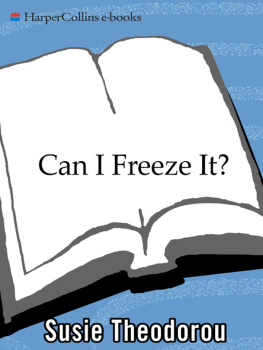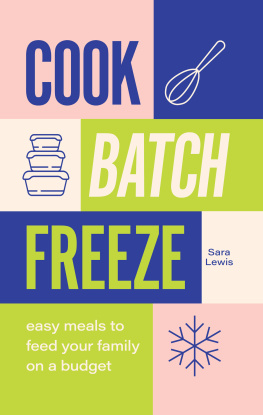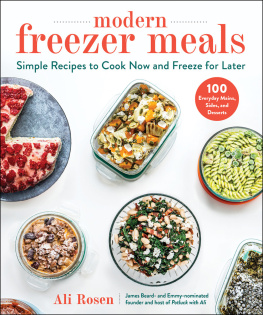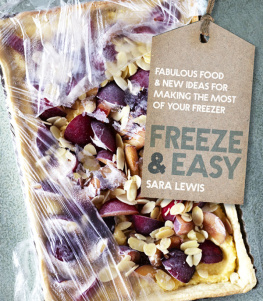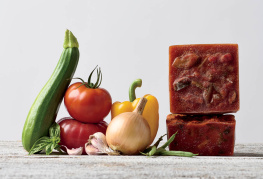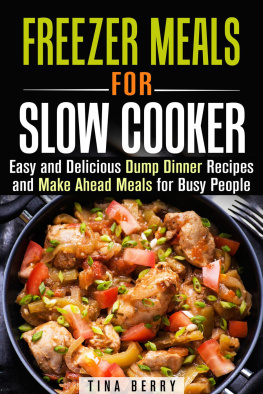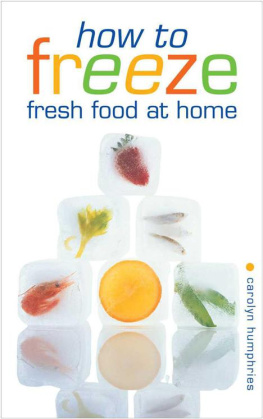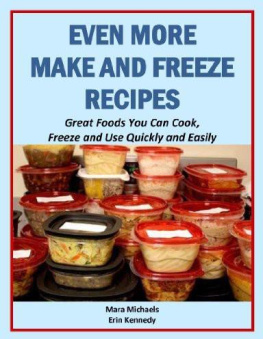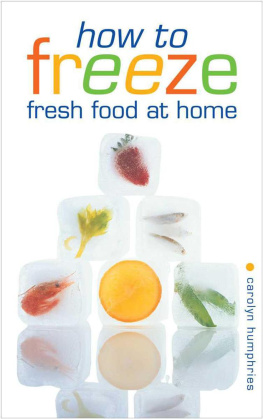Can I Freeze It?
How to Use the Most Versatile Appliance in Your Kitchen
Susie Theodorou
Photography by Deirdre Rooney


To my mother, grandmothers, and auntsall wonderful cooks

Contents

A cookbook, no matter how big or small, cannot be done without the help of friends and colleaguesespecially when one is a freelancer.
The biggest thank you must go to Beth Pilar and Deirdre Rooney. Beth, for her patience and care in testing many of the recipes and for her honest comments. Deirdre, for her guidance in art direction and beautiful photographs for this book. I remember it was so, so hot during the shoots, but Deirdre and Beth worked super-hard and with humorthere was no air-conditioning in the studio! It was fun, but not always easy.
To Frigidaire, for the loan of a smart standup, frost-free freezer that was a great help during the writing, testing, and photographing of the recipes for this book.
To Staub USA Inc. and Le Creuset of America Inc. for the use of their beautiful pots, cocottes, roasting dishes, wok, and grill pan used for testing the recipes and in some of the photographsthank you.
A big thank you to Jean Conlon, Clive Streeter, and Valerie Berry for the loan of their studios for the shoots.
To my dear art-director friends, Matthew Axe and Scot Schy, who offered me sound advice during the shoots. They listened to me on short noticemost appreciated. Thank you.
Thank you so much to my family of friends in New York who put up with the dinner parties in my non-air-conditioned apartment, where shamelessly I pushed my recipes on them. All your comments were taken on board.
To Jane Druker, Bill Tikos, and Liz Marcy for helping me get this book off the ground, into a project, and finally a book. Thank you.
To Level for their designI am very happy our paths have crossed.
And finally, thank you to Harriet Bell for believing in this idea, and to everyone at HarperCollins who has guided me through the stages of producing a book.
In many homes, the freezer is nothing more than a place to display family photos and childrens artwork, attached with a collection of magnets. Or, worse still, the freezer can be a dusty repository in the basement or garage to which too-good-to-pass-up supermarket bargains are consigned, never to be used.
Can I Freeze It? will help you transform your freezer into the most essential appliance in your kitchen, allowing you to prepare family meals as well as dishes for entertaining well ahead of time. If the cupboard is bare, at least the freezer will be full of make-ahead meals, sweet and savory frozen pies, and other dishes.
Can I freeze it? is the question Im most often asked when giving out recipes. This book explains what you can and cant freeze successfully and offers lots of recipes that show how to use your freezer to its best advantage. On the other hand, this isnt an encyclopedic guide to preparing and freezing seasonal fruits and vegetables from the garden or farmers market. You will find information on how to make the most of your freezer space, how to freeze foods effectively, and most of all how to prepare dishes for the freezer without it becoming a chore.


how freezing works
Freezing preserves food by slowing down the growth of the microorganisms that cause decay. It does not kill microorganisms; but to grow they require water, and if the water within the cells of the food has been turned into ice, that means it is unavailable for bacterial growth and chemical reactions.
In order to achieve proper freezing and prevention of decay, a constant temperature of 0F/-18C or less is required. Some freezers cannot achieve or are not kept at that temperature. If the temperature in the freezer fluctuates, the length of time foods can be kept is reduced considerably. In order to help maintain the lowest possible temperature, keep freezer doors closed as much as possible, add small quantities of unfrozen food at a time, and make sure that all prepared food has cooled to room temperature before it is placed in the freezer.
The faster food is frozen, the better, as fast freezing creates smaller ice crystals. Food that is frozen slowly develops large ice crystals that can pierce the cell walls, possibly causing a compromise in the flavor and texture of many foods.
Always place unfrozen food in the coldest part of the freezer until solid, then organize the freezer as appropriate, with foods that are to be stored the longest kept in the coldest parts at the back, and foods that will be used quickly kept close to the front or on top.
Many freezers have a fast-freeze switch, which lowers the temperature to enable food to be frozen more quickly. Once the food is solid, turn off the fast-freeze switch. Other models have a thermostat dial so you can turn the dial to its lowest temperature setting while the food is freezing and then once the food is frozen solid, return the dial to the original setting. Dont forget to do so, as these dials may also control the temperature within the refrigerator.
Last, a word on what happens when freezing goes wrong. The telltale sign of freezer burn is a frosty, gray appearance on the surface of the food; freezer burn can cause the prepared food to taste spoiled and tough. This happens when air dries out the surface of the food as it is in the freezer. It can easily be prevented by wrapping the foods tightly with the correct materials.
freezing tips and techniques

When freezing food, make sure you leave plenty of clear space around each container or package you are freezing to allow the air to flow around the unfrozen food and freeze the food quickly and evenly. After the packages are frozen, stack them more efficiently.
Foods frozen in smaller quantities will freeze faster than foods frozen in larger quantities, helping to prevent a buildup of large ice crystals.
Use shallow containers with a wide surface area relative to depth. This will enable food to freeze quickly all the way through. If using plastic freezer bags for meats, vegetables, sauces, or soups, seal them well, then place them flat on a chilled baking sheet until frozen solid. Again, a wide surface area will aid in the formation of tiny ice crystals and will also make for faster thawing.
It is important to cool food completely to room temperature before freezing. Placing hot foods in the freezer will raise its temperature, slowing down the freezing time and possibly thawing other foods, and the centers of the foods may not freeze quickly enough to prevent spoilage.

